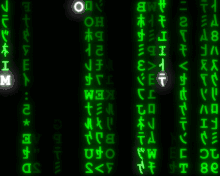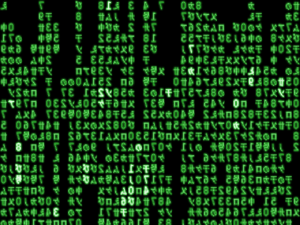Matrix digital rain
Matrix digital rain, Matrix code or sometimes green rain, is the computer code featured in the Matrix series. The falling green code is a way of representing the activity of the virtual reality environment of the Matrix on screen. All three Matrix movies, as well as the spin-off The Animatrix episodes, open with the code. It is a characteristic mark of the franchise, similar to the opening crawl in Star Wars.

Background
In the film, the code that comprises the Matrix itself is frequently represented as downward-flowing green characters. This code uses a custom typeface designed by Simon Whiteley,[1] which includes mirror images of half-width kana characters and Western Latin letters and numerals.[2] In a 2017 interview at CNET, he attributed the design to his wife, who comes from Japan, and added, "I like to tell everybody that The Matrix's code is made out of Japanese sushi recipes".[3] The effect resembles that of the older green screen displays, since the letters leave a fluorescent trace on the screen.[4]
One predecessor of the digital rain exists in a "code-scene" of the movie Meteo, a Hungarian experimental-pop culture movie from 1989. The 1995 cyberpunk film Ghost in the Shell, a strong influence on The Matrix,[5][6] features opening credits similar to the digital rain.
No official version of the code's typeface actually used in the Matrix trilogy and in the website for the game Path of Neo has been released. Several imitations have been made, mostly in the form of screensavers.
Cultural impact

Dutch musician Arjen Anthony Lucassen named a track "Digital Rain", in honour of the movie, on his 2010 album Victims of the Modern Age by his band Star One.
The effect also inspired the creation of many unofficial Matrix screensavers.[7]
See also
References
- Powerhouse Museum. "'The Matrix' film poster". Powerhouse Museum, Australia. Retrieved December 24, 2012.
- Oreck, Josh (Director); Wachowski, Larry; Matthies, Eric (Producers) (November 20, 2001). "Look of the Matrix". The Matrix Revisited (DVD). United States: Warner Bros. Pictures.
- Bisset, Jennifer (October 19, 2017). "Creator of The Matrix code reveals its mysterious origins". CNET. Retrieved November 5, 2018.
- Clover, Joshua (2004). The Matrix. London: BFI Publishing. pp. 8–9. ISBN 1844570452.
In the denouement [of The Thirteenth Floor], Douglas Hall simply crests a hill to discover that what he had thought was the real world has, beyond this point, yet to be constructed. In lieu of landscape, only crude phosphor-green polygons, the basic units of video graphics rendering, in the primal monochrome of an old CRT. The raw material of the simulation is even more basic in The Matrix – machine language itself, in the same familiar green...
- Joel Silver, interviewed in "Scrolls to Screen: A Brief History of Anime" featurette on The Animatrix DVD.
- Joel Silver, interviewed in "Making The Matrix" featurette on The Matrix DVD.
- Podolsky, Erin (March 2, 2001). "Saver the Moment: movie inspired screen savers". Entertainment Weekly. Retrieved 22 June 2017.